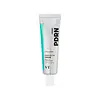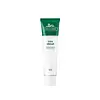What's inside
What's inside
 Key Ingredients
Key Ingredients

 Benefits
Benefits

 Concerns
Concerns

 Ingredients Side-by-side
Ingredients Side-by-side

Water
Skin ConditioningButylene Glycol
HumectantGlycerin
HumectantPropanediol
SolventC12-15 Alkyl Benzoate
AntimicrobialCaprylic/Capric Triglyceride
MaskingPolyglycerin-3
HumectantMethyl Hydrogenated Rosinate
Perfuming1,2-Hexanediol
Skin ConditioningNiacinamide
SmoothingCaprylic/Capric/Myristic/Stearic Triglyceride
EmollientC14-22 Alcohols
Emulsion StabilisingBis-Diglyceryl Polyacyladipate-2
EmollientVinyldimethicone
Cetearyl Alcohol
EmollientPanthenol
Skin ConditioningGlyceryl Stearate
EmollientBetaine
HumectantC12-20 Alkyl Glucoside
EmulsifyingPolyacrylate-13
Palmitic Acid
EmollientHydrogenated Vegetable Oil
EmollientStearic Acid
CleansingCetearyl Glucoside
EmulsifyingHydrogenated Polyisobutene
EmollientMacadamia Ternifolia Seed Oil
EmollientTromethamine
BufferingGlyceryl Acrylate/Acrylic Acid Copolymer
HumectantCarbomer
Emulsion StabilisingXanthan Gum
EmulsifyingEthylhexylglycerin
Skin ConditioningAllantoin
Skin ConditioningAdenosine
Skin ConditioningPolyglyceryl-10 Laurate
Skin ConditioningEthylhexyl Palmitate
EmollientDisodium EDTA
Sorbitan Isostearate
EmulsifyingGellan Gum
Agar
MaskingSqualane
EmollientHydrogenated Lecithin
EmulsifyingMelia Azadirachta Leaf Extract
Skin ConditioningMelia Azadirachta Flower Extract
Skin ConditioningCoccinia Indica Fruit Extract
Skin ConditioningSodium Hyaluronate
HumectantSolanum Melongena Fruit Extract
Skin ConditioningHydrolyzed Elastin
EmollientPanax Ginseng Root Extract
EmollientEclipta Prostrata Extract
Skin ConditioningOcimum Sanctum Leaf Extract
Skin ConditioningCorallina Officinalis Extract
Skin ConditioningSimmondsia Chinensis Seed Oil
EmollientCurcuma Longa Root Extract
MaskingAmber Powder
Potassium Hyaluronate
Skin ConditioningHydroxypropyltrimonium Hyaluronate
Hydrolyzed Sodium Hyaluronate
Skin ConditioningHydrolyzed Hyaluronic Acid
HumectantHyaluronic Acid
HumectantHydrolyzed Collagen
EmollientCaprylyl Glycol
EmollientMoringa Oleifera Seed Oil
EmollientCeramide NP
Skin ConditioningPentylene Glycol
Skin ConditioningSodium Dna
Skin ConditioningSodium Hyaluronate Crosspolymer
HumectantCeramide Ns
Skin ConditioningSodium Acetylated Hyaluronate
HumectantPhytosphingosine
Skin ConditioningCitric Acid
BufferingCholesterol
EmollientSodium Guaiazulene Sulfonate
Ceramide As
Skin ConditioningCeramide AP
Skin ConditioningCeramide EOP
Skin ConditioningParfum
MaskingWater, Butylene Glycol, Glycerin, Propanediol, C12-15 Alkyl Benzoate, Caprylic/Capric Triglyceride, Polyglycerin-3, Methyl Hydrogenated Rosinate, 1,2-Hexanediol, Niacinamide, Caprylic/Capric/Myristic/Stearic Triglyceride, C14-22 Alcohols, Bis-Diglyceryl Polyacyladipate-2, Vinyldimethicone, Cetearyl Alcohol, Panthenol, Glyceryl Stearate, Betaine, C12-20 Alkyl Glucoside, Polyacrylate-13, Palmitic Acid, Hydrogenated Vegetable Oil, Stearic Acid, Cetearyl Glucoside, Hydrogenated Polyisobutene, Macadamia Ternifolia Seed Oil, Tromethamine, Glyceryl Acrylate/Acrylic Acid Copolymer, Carbomer, Xanthan Gum, Ethylhexylglycerin, Allantoin, Adenosine, Polyglyceryl-10 Laurate, Ethylhexyl Palmitate, Disodium EDTA, Sorbitan Isostearate, Gellan Gum, Agar, Squalane, Hydrogenated Lecithin, Melia Azadirachta Leaf Extract, Melia Azadirachta Flower Extract, Coccinia Indica Fruit Extract, Sodium Hyaluronate, Solanum Melongena Fruit Extract, Hydrolyzed Elastin, Panax Ginseng Root Extract, Eclipta Prostrata Extract, Ocimum Sanctum Leaf Extract, Corallina Officinalis Extract, Simmondsia Chinensis Seed Oil, Curcuma Longa Root Extract, Amber Powder, Potassium Hyaluronate, Hydroxypropyltrimonium Hyaluronate, Hydrolyzed Sodium Hyaluronate, Hydrolyzed Hyaluronic Acid, Hyaluronic Acid, Hydrolyzed Collagen, Caprylyl Glycol, Moringa Oleifera Seed Oil, Ceramide NP, Pentylene Glycol, Sodium Dna, Sodium Hyaluronate Crosspolymer, Ceramide Ns, Sodium Acetylated Hyaluronate, Phytosphingosine, Citric Acid, Cholesterol, Sodium Guaiazulene Sulfonate, Ceramide As, Ceramide AP, Ceramide EOP, Parfum
Water
Skin ConditioningGlycerin
HumectantButylene Glycol
HumectantDimethicone
EmollientPEG-8 Caprylic/Capric Glycerides
EmulsifyingCetyl Ethylhexanoate
EmollientCetearyl Olivate
Acrylates/C10-30 Alkyl Acrylate Crosspolymer
Emulsion StabilisingSorbitan Olivate
EmulsifyingTromethamine
BufferingPhenoxyethanol
PreservativeAmmonium Acryloyldimethyltaurate/Vp Copolymer
Beeswax
Emulsion StabilisingChlorphenesin
AntimicrobialParfum
MaskingEthylhexylglycerin
Skin ConditioningCaprylyl Glycol
EmollientPanthenol
Skin ConditioningMelia Azadirachta Leaf Extract
Skin ConditioningArtemisia Princeps Leaf Extract
Skin ConditioningBenzophenone-5
UV AbsorberPortulaca Oleracea Extract
Skin ConditioningAlcohol
AntimicrobialDisodium EDTA
Melia Azadirachta Flower Extract
Skin ConditioningTheobroma Cacao Extract
Skin Conditioning1,2-Hexanediol
Skin ConditioningSodium Hyaluronate
HumectantDextrin
AbsorbentCentella Asiatica Extract
CleansingCaprylic/Capric Triglyceride
MaskingCeramide NP
Skin ConditioningHydrogenated Lecithin
EmulsifyingCinnamomum Camphora Leaf Extract
MaskingBeta-Glucan
Skin ConditioningPropolis Extract
Skin ConditioningAsiaticoside
AntioxidantMadecassoside
AntioxidantAsiatic Acid
Skin ConditioningWater, Glycerin, Butylene Glycol, Dimethicone, PEG-8 Caprylic/Capric Glycerides, Cetyl Ethylhexanoate, Cetearyl Olivate, Acrylates/C10-30 Alkyl Acrylate Crosspolymer, Sorbitan Olivate, Tromethamine, Phenoxyethanol, Ammonium Acryloyldimethyltaurate/Vp Copolymer, Beeswax, Chlorphenesin, Parfum, Ethylhexylglycerin, Caprylyl Glycol, Panthenol, Melia Azadirachta Leaf Extract, Artemisia Princeps Leaf Extract, Benzophenone-5, Portulaca Oleracea Extract, Alcohol, Disodium EDTA, Melia Azadirachta Flower Extract, Theobroma Cacao Extract, 1,2-Hexanediol, Sodium Hyaluronate, Dextrin, Centella Asiatica Extract, Caprylic/Capric Triglyceride, Ceramide NP, Hydrogenated Lecithin, Cinnamomum Camphora Leaf Extract, Beta-Glucan, Propolis Extract, Asiaticoside, Madecassoside, Asiatic Acid
Ingredients Explained
These ingredients are found in both products.
Ingredients higher up in an ingredient list are typically present in a larger amount.
1,2-Hexanediol is a synthetic liquid and another multi-functional powerhouse.
It is a:
- Humectant, drawing moisture into the skin
- Emollient, helping to soften skin
- Solvent, dispersing and stabilizing formulas
- Preservative booster, enhancing the antimicrobial activity of other preservatives
Butylene Glycol (or BG) is used within cosmetic products for a few different reasons:
Overall, Butylene Glycol is a safe and well-rounded ingredient that works well with other ingredients.
Though this ingredient works well with most skin types, some people with sensitive skin may experience a reaction such as allergic rashes, closed comedones, or itchiness.
Learn more about Butylene GlycolThis ingredient is an emollient, solvent, and texture enhancer. It is considered a skin-softener by helping the skin prevent moisture loss.
It helps thicken a product's formula and makes it easier to spread by dissolving clumping compounds.
Caprylic Triglyceride is made by combining glycerin with coconut oil, forming a clear liquid.
While there is an assumption Caprylic Triglyceride can clog pores due to it being derived from coconut oil, there is no research supporting this.
Learn more about Caprylic/Capric TriglycerideCaprylyl Glycol is a humectant and emollient, meaning it attracts and preserves moisture.
It is a common ingredient in many products, especially those designed to hydrate skin. The primary benefits are retaining moisture, skin softening, and promoting a healthy skin barrier.
Though Caprylyl Glycol is an alcohol derived from fatty acids, it is not the kind that can dry out skin.
This ingredient is also used as a preservative to extend the life of products. It has slight antimicrobial properties.
Learn more about Caprylyl GlycolCeramide NP is a type of ceramide.
Ceramides are intercellular lipids naturally found in our skin that bonds dead skin cells together to create a barrier. They are known for their ability to hold water and thus are a great ingredient for dry skin.
Ceramides are an important building block for our skin barrier. A stronger barrier helps the skin look more firm and hydrated. By bolstering the skin ceramides act as a barrier against irritating ingredients. This can help with inflammation as well.
If you would like to eat ceramides, sweet potatoes contain a small amount.
Read more about other common types of ceramides here:
Ceramide AP
Ceramide EOP
Disodium EDTA plays a role in making products more stable by aiding other preservatives.
It is a chelating agent, meaning it neutralizes metal ions that may be found in a product.
Disodium EDTA is a salt of edetic acid and is found to be safe in cosmetic ingredients.
Learn more about Disodium EDTAEthylhexylglycerin (we can't pronounce this either) is commonly used as a preservative and skin softener. It is derived from glyceryl.
You might see Ethylhexylglycerin often paired with other preservatives such as phenoxyethanol. Ethylhexylglycerin has been found to increase the effectiveness of these other preservatives.
Glycerin is already naturally found in your skin. It helps moisturize and protect your skin.
A study from 2016 found glycerin to be more effective as a humectant than AHAs and hyaluronic acid.
As a humectant, it helps the skin stay hydrated by pulling moisture to your skin. The low molecular weight of glycerin allows it to pull moisture into the deeper layers of your skin.
Hydrated skin improves your skin barrier; Your skin barrier helps protect against irritants and bacteria.
Glycerin has also been found to have antimicrobial and antiviral properties. Due to these properties, glycerin is often used in wound and burn treatments.
In cosmetics, glycerin is usually derived from plants such as soybean or palm. However, it can also be sourced from animals, such as tallow or animal fat.
This ingredient is organic, colorless, odorless, and non-toxic.
Glycerin is the name for this ingredient in American English. British English uses Glycerol/Glycerine.
Learn more about GlycerinHydrogenated Lecithin is created from the hydrogenation of lecithin (a group of phospholipids). Hydrogenation is a chemical reaction between hydrogen and another element.
This ingredient is an emollient and emulsifier. As an emollient, it helps soften skin by trapping moisture within. As an emulsifier, it prevents oil and water ingredients from separating.
Melia Azadirachta Flower Extract is from the Neem tree. Neem trees originate from India.
Melia Azadirachta Flower Extract contains antioxidants. Antioxidants help fight free-radicals. Free-radicals are molecules that may damage your skin cells, such as pollution.
The flowers of this tree are lilac colored.
Learn more about Melia Azadirachta Flower ExtractMelia Azadirachta Leaf Extract is extract from the neem plant.
The leaves of this tree contain flavonoids and polyphenols. These two compounds are antioxidants, anti-inflammatory, and antibacterial. Further research is needed as to their effects when applied on skin.
Panthenol is a common ingredient that helps hydrate and soothe the skin. It is found naturally in our skin and hair.
There are two forms of panthenol: D and L.
D-panthenol is also known as dexpanthenol. Most cosmetics use dexpanthenol or a mixture of D and L-panthenol.
Panthenol is famous due to its ability to go deeper into the skin's layers. Using this ingredient has numerous pros (and no cons):
Like hyaluronic acid, panthenol is a humectant. Humectants are able to bind and hold large amounts of water to keep skin hydrated.
This ingredient works well for wound healing. It works by increasing tissue in the wound and helps close open wounds.
Once oxidized, panthenol converts to pantothenic acid. Panthothenic acid is found in all living cells.
This ingredient is also referred to as pro-vitamin B5.
Learn more about PanthenolParfum is a catch-all term for an ingredient or more that is used to give a scent to products.
Also called "fragrance", this ingredient can be a blend of hundreds of chemicals or plant oils. This means every product with "fragrance" or "parfum" in the ingredients list is a different mixture.
For instance, Habanolide is a proprietary trade name for a specific aroma chemical. When used as a fragrance ingredient in cosmetics, most aroma chemicals fall under the broad labeling category of “FRAGRANCE” or “PARFUM” according to EU and US regulations.
The term 'parfum' or 'fragrance' is not regulated in many countries. In many cases, it is up to the brand to define this term.
For instance, many brands choose to label themselves as "fragrance-free" because they are not using synthetic fragrances. However, their products may still contain ingredients such as essential oils that are considered a fragrance by INCI standards.
One example is Calendula flower extract. Calendula is an essential oil that still imparts a scent or 'fragrance'.
Depending on the blend, the ingredients in the mixture can cause allergies and sensitivities on the skin. Some ingredients that are known EU allergens include linalool and citronellol.
Parfum can also be used to mask or cover an unpleasant scent.
The bottom line is: not all fragrances/parfum/ingredients are created equally. If you are worried about fragrances, we recommend taking a closer look at an ingredient. And of course, we always recommend speaking with a professional.
Learn more about ParfumSodium Hyaluronate is hyaluronic acid's salt form. It is commonly derived from the sodium salt of hyaluronic acid.
Like hyaluronic acid, it is great at holding water and acts as a humectant. This makes it a great skin hydrating ingredient.
Sodium Hyaluronate is naturally occurring in our bodies and is mostly found in eye fluid and joints.
These are some other common types of Hyaluronic Acid:
Learn more about Sodium HyaluronateTromethamine helps balance the pH and improve the texture of a product. It is synthetically created.
As an emulsifier, Tromethamine prevents oil and water ingredients from separating. This helps stabilize the product and elongate a product's shelf life. Tromethamine also makes a product thicker.
Tromethamine helps balance the pH level of a product. Normal pH level of skin is slightly acidic (~4.75-5.5). The acidity of our skin is maintained by our glands and skin biome. Being slightly acidic allows our skin to create an "acid mantle". This acid mantle is a thin barrier that protects our skin from bacteria and contaminants.
Oral Tromethanmine is an anti-inflammatory drug but plays the role of masking, adding fragrance, and/or balancing pH in skincare.
1,3-Propanediol, 2-amino-2-(hydroxymethyl)-
Learn more about TromethamineWater. It's the most common cosmetic ingredient of all. You'll usually see it at the top of ingredient lists, meaning that it makes up the largest part of the product.
So why is it so popular? Water most often acts as a solvent - this means that it helps dissolve other ingredients into the formulation.
You'll also recognize water as that liquid we all need to stay alive. If you see this, drink a glass of water. Stay hydrated!
Learn more about Water